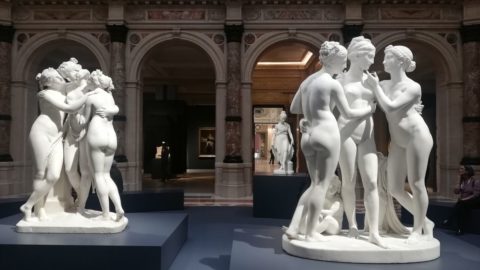The poetry of art takes center stage at the Gallerie d'Italia in Milan – Piazza Scala. The museum headquarters of Intesa Sanpaolo in the Lombard capital becomes the custodian of the 'Canova | Thorvaldsen. The birth of modern sculpture', curated by Stefano Grandesso and Fernando Mazzocca.
With its 160 works, the exhibition represents, both for the importance and beauty of the exhibited works and for their scientific relevance, the opportunity to travel the bridge of art between the eighteenth and nineteenth centuries, an artistic moment where sculpture underwent a decisive transformation thanks to the genius of the Italian Antonio Canova and the Danish Bertel Thorvaldsen, protagonists and rivals on the scene of a cosmopolitan Rome where they had the opportunity to confront the universal values of classicism and ancient. It is precisely on Roman soil that the two sculptors originally faced each other and where both developed a good part of their careers: Canova arrived in Rome in 1781 and died there in 1822, while Thorvaldsen settled there starting from 1797 and for the next forty 'years.
Over the course of their careers, the two have given rise to one of the best known and most productive competitions on identical themes and subjects, which have given art some masterpieces: the figures of classical mythology, such as Cupid and Psyche, Venus, Paris, Hebe, the Graces, represented in the common imagination the incarnation of the great universal themes of life, such as the short journey of youth, the enchantment of beauty, the flattery and disappointments of love. Canova was the revolutionary artist, capable of assigning primacy to sculpture over the other arts, through the comparison and overcoming of the ancients, where his works in dialogue with the space that surround them manage to exalt themselves again, in the dynamic and sinuous lines that characterize them. Thorvaldsen, studying the rival's work and strategy, was inspired by a more austere and nostalgic idea of classicism, in which the confrontation with the spectator is not total, the lines are more anatomical and help to create a distance with the public. The Danish sculptor became the forerunner of a new era of Nordic art dominated by the timeless charm of the Mediterranean world.
Made in collaboration with the State Hermitage Museum in St. Petersburg and with the Thorvaldsen Museum in Copenhagen, the exhibition is made possible by the contribution of fundamental loans granted by Italian and foreign museums and private collections: the Vatican Apostolic Library, the Uffizi Galleries in Florence, the J. Paul Getty Museum in Los Angeles, the Museo Nacional del Prado in Madrid, the Pinacoteca di Brera and the Pinacoteca della Veneranda Biblioteca Ambrosiana in Milan, the Metropolitan Museum in New York, the National Galleries of Ancient Art in Rome, the Gallerie dell'Accademia in Venice.
"This exhibition, from 25 October to 15 March 2020, represents a milestone of great significance in the process of enhancing Italian art and culture undertaken by our Gallerie d'Italia - said Giovanni Bazoli, President Emeritus of Intesa Sanpaolo - It is a path that is assuming ever greater international importance. For the first time, the works of the two great sculptors, the Italian Canova and the Danish Thorvaldsen, are presented to the public in direct comparison. Also with this exhibition, our bank confirms its pride in transfusing its trust in the universal values of culture and beauty into a daily commitment"
The exhibition, in fact, continues the cycle of exhibitions held at the Gallerie d'Italia as part of the Intesa Sanpaolo Culture Project, aimed at enhancing the protagonists and seasons of the history of Italian art.





